For enterprises seeking a robust digital commerce foundation in 2025, the decision often comes down to SAP Commerce Cloud vs Magento (Adobe Commerce). Both platforms are powerful, but they serve different priorities and business models. Both are powerful platforms, but they serve very different business needs, one rooted in SAP’s enterprise ecosystem, the other built for flexible, experience-led commerce
This guide compares the two platforms across the most critical factors for enterprise decision-makers:
- Pricing & TCO
- Architecture & tech stack
- Core commerce
- B2B/B2C capabilities
- Scalability and performance under load
- Ease of use and customizability
- Multichannel and mobile experience
- Marketing, personalization, and SEO tools
- Security and support
Let’s get in!
Platform Overview and Evolution
What is SAP Commerce Cloud (formerly SAP Hybris)?
SAP Commerce Cloud is the enterprise eCommerce platform within the SAP Customer Experience (SAP CX) suite. Originally launched as Hybris, a cloud-based digital commerce solution for both B2B and B2C, it was acquired by SAP in 2013. Since then, it has evolved into a cloud-native, API-first platform designed for complex, large-scale business scenarios.
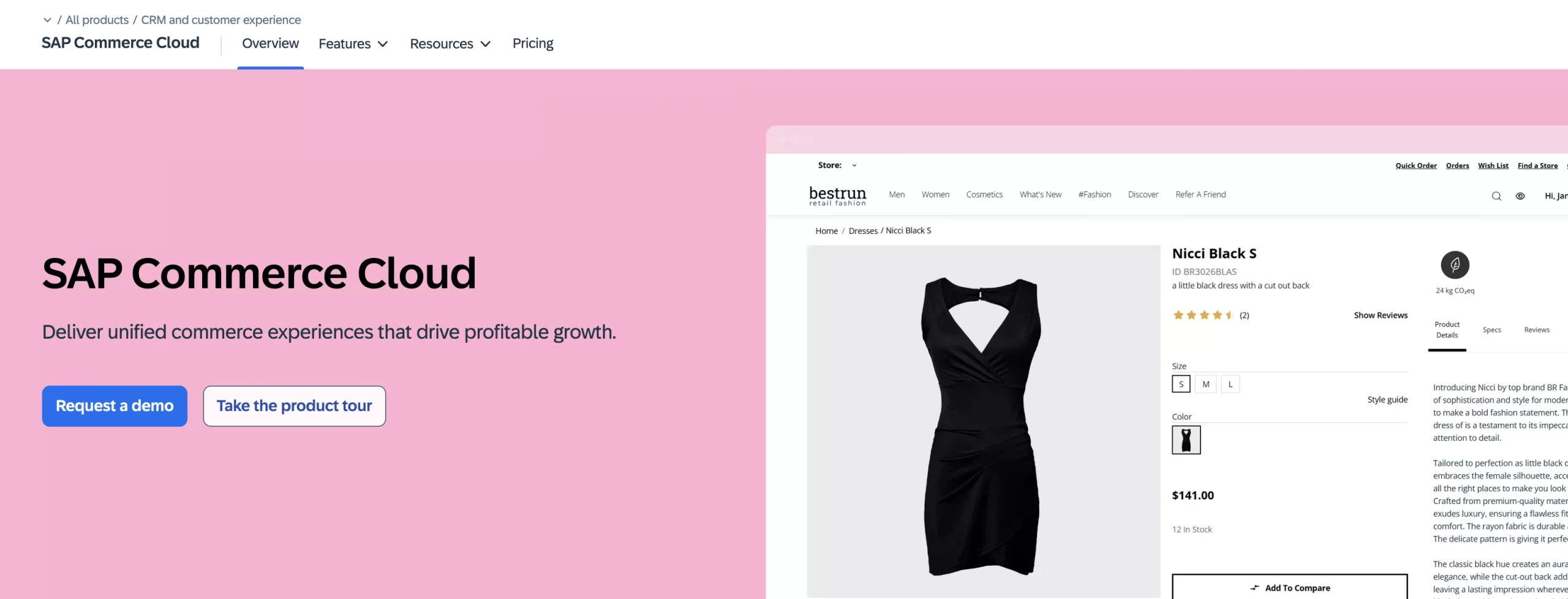
Today, SAP Commerce Cloud runs on Microsoft Azure and is deeply integrated with SAP’s broader ecosystem, especially SAP S/4HANA, SAP ERP, and SAP Customer Data Cloud. It is known for its ability to handle:
- Complex B2B scenarios like contract pricing, quoting, and approval flows
- Multi-site, multi-language, and multi-catalog architectures
- End-to-end SAP integration for enterprise data governance
SAP Commerce Cloud is best suited for global enterprises operating in regulated or multi-entity environments, particularly those already invested in SAP infrastructure.
What is Adobe Commerce (powered by Magento)?
Adobe Commerce is the enterprise version of the Magento platform, integrated into the Adobe Experience Platform following Adobe’s acquisition of Magento in 2018. Positioned alongside tools like Adobe Analytics, Adobe Target, Adobe Experience Manager (AEM), and Adobe Sensei, Adobe Commerce empowers businesses to deliver unified, personalized, and content-driven commerce experiences.
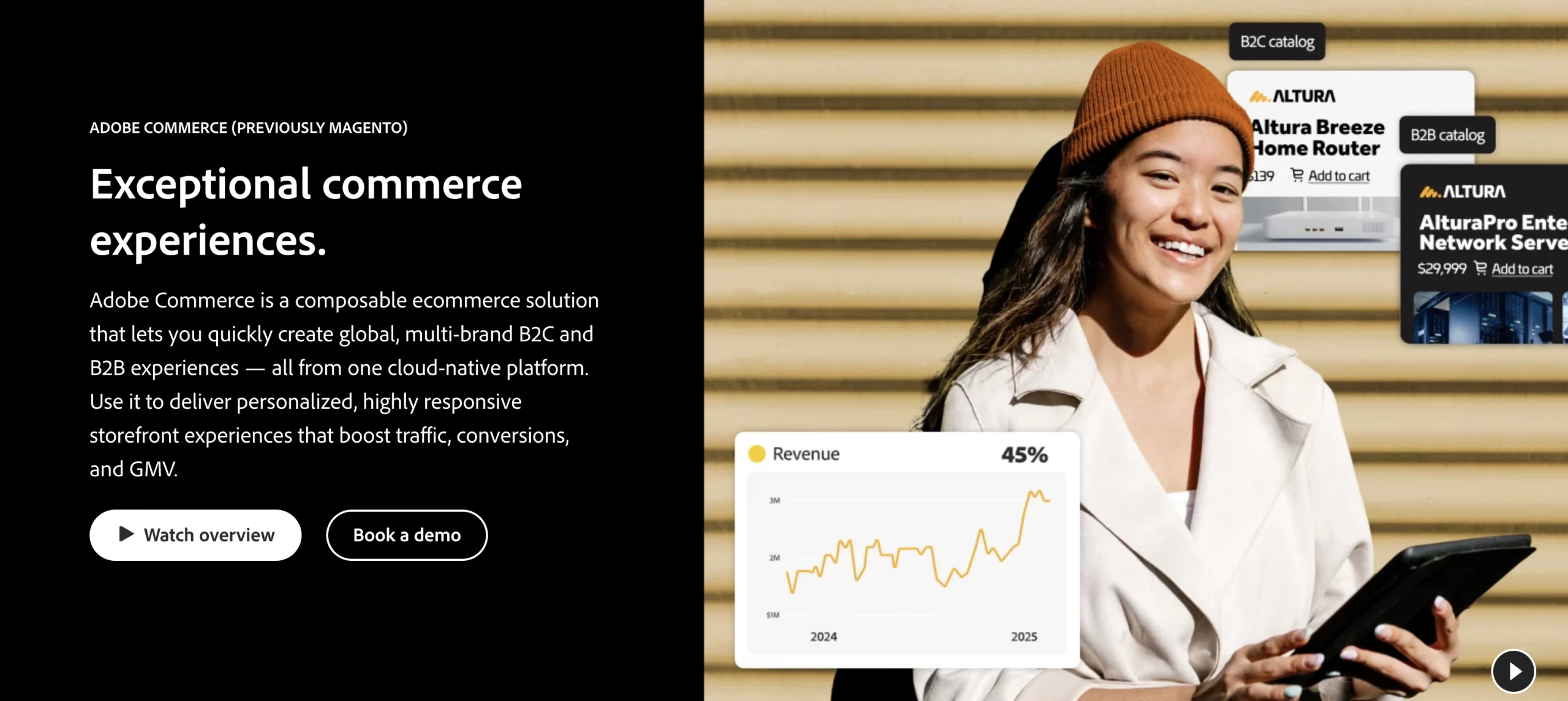
Unlike the open-source Magento edition, Adobe Commerce provides enterprise capabilities such as:
- Advanced B2B features (company accounts, shared catalogs, custom pricing)
- Powerful Page Builder for content management
- AI-driven product recommendations via Adobe Sensei
- Seamless integration with Adobe’s marketing and data platforms
Adobe Commerce is ideal for brands that prioritize experience-led commerce, rapid innovation, and content-personalization at scale, particularly those already within the Adobe Experience ecosystem.
Pricing and Total Cost of Ownership (TCO)
Understanding the full cost of adopting SAP Commerce Cloud vs Magento (Adobe Commerce) requires looking beyond base licenses. Below is a breakdown of each platform’s pricing models and long-term ownership considerations.
Adobe Commerce Cloud pricing
As of 2025, Adobe Commerce offers multiple deployment models:
- Adobe Commerce as a Cloud Service (SaaS)
- Adobe Commerce on Cloud (PaaS)
- Adobe Commerce Optimizer (for existing setups)
Pricing is quote-based and primarily calculated on Gross Merchandise Value (GMV) and Average Order Value (AOV). While exact pricing varies, typical enterprise plans range from: $40,000 to $200,000+ per year depending on scale, usage, and features.
Contracts are flexible, with annual or usage-based options, and include hosting, support, and maintenance in cloud tiers.
SAP Commerce Cloud pricing
SAP Commerce Cloud offers two editions:
- Composable Edition
- Premier Edition
Pricing is based on order volume, sold in blocks of 50,000 orders per year. Buying conditions include:
- Contract duration: Minimum 3 months, maximum 60 months
- Auto-renewal: Enabled by default
- Minimum purchase: 1 order block (50,000/year)
While SAP does not publish list prices, estimates suggest it will cost $150,000 to $500,000+ per year, depending on edition, volume, and implementation complexity.
This long-term model aligns well with large enterprises invested in the SAP ecosystem — especially those choosing between SAP Hybris vs Magento or comparing the value of Adobe Experience Platform vs SAP.
Here’s a summary table on SAP Commerce Cloud vs Magento Adobe Commerce cost:
| Cost area | SAP Commerce Cloud | Adobe Commerce (Cloud) |
| Base license | ~$150K–$500K+/year (per 50K orders/year) | ~$40K–$200K+/year (based on GMV & AOV) |
| Contract terms | 3–5 years, auto-renewal by default | Annual or usage-based; flexible |
| Hosting & infra | Azure-hosted, managed by SAP (included) | Hosting included (SaaS or PaaS) |
| Customization | Requires SAP-certified devs and ecosystem modules | Large extension marketplace, open customization |
| Integration | Native to SAP tools (S/4HANA, Emarsys, CDP) | Native to Adobe tools (AEM, Analytics, Target) |
| Support & maintenance | Separate SAP support contract required | Included in enterprise cloud plans |
| Implementation cost | High (longer onboarding, certified partners) | Medium (broad partner base, faster onboarding) |
Verdict: It depends.
- Choose Adobe Commerce if you prioritize speed-to-market, rich personalization, and modular TCO, which are ideal for content-led or omnichannel brands.
- Choose SAP Commerce Cloud if you're a large enterprise with deep SAP investments, requiring long-term scale, B2B complexity, and tight ERP integration, even if it comes with a higher upfront and ownership cost.
Feature Comparison: Adobe Commerce vs SAP Commerce Cloud
Before we jump into the feature comparison, let’s have a quick look at the table below. It provides a side-by-side comparison of SAP Commerce Cloud vs Magento (Adobe Commerce), focusing on what matters most to strategic decision-makers, not developers.
Criteria | SAP Commerce Cloud | Adobe Commerce (Magento) | Verdict |
Architecture & Tech stack | Java-based, cloud-native on Azure; API-first; built for SAP BTP and ERP orchestration | PHP-based, modular, PaaS or SaaS, GraphQL, REST; integrates with Adobe Experience Platform | SAP wins — enterprise-grade governance |
Core commerce features | Deep backend orchestration, enterprise-level catalog/price control, sourcing logic | Visual rule builder, multi-product types, flexible checkout & cart, strong for D2C agility | Adobe wins — better business autonomy |
B2B & B2C capabilities | B2B Accelerator, contract pricing, CPQ, approval workflows | Hybrid-ready, shared catalogs, PO flows, quick order tools | SAP wins — stronger native B2B suite |
Scalability & Performance | Multi-region scaling, auto-scaling via Azure, SLA-backed uptime | Elastic scaling, Fastly CDN, performance tools, PWA Studio | SAP wins — built for global throughput |
Ease of use & Customizability | Powerful but complex UI, developer-dependent, Spring-based customization | Drag-and-drop Page Builder, low-code tools, extensive extensions | Adobe wins — more user-friendly |
Multichannel & Mobile | Spartacus frontend, multichannel orchestration, POS via SAP stack | Native PWA, multi-store, marketplace integration, POS-ready | Adobe wins — faster omnichannel setup |
Marketing & Personalization | Emarsys lifecycle automation, SAP CDC, predictive journeys | Adobe Sensei AI, segmentation, Target/AEM integration | Adobe wins — stronger marketer tools |
SEO & Content management | SmartEdit, basic SEO, CMS extensions needed | Page Builder CMS, SEO control, schema, staging, preview | Adobe wins — better content agility |
Support & Documentation | SLA-based support, PartnerEdge, closed ecosystem | Public docs, active community, broad partner options | Adobe wins — accessible, flexible help |
Security & Compliance | ISO/SOC/GDPR compliance, SAP CDC, audit-grade governance | PCI Level 1, frequent patches, Adobe Trust Center, real-time scanner | Tie — Adobe excels in admin security and patching; SAP leads in compliance and identity management |
1. Architecture and tech stack
SAP Commerce Cloud is a Java-based, cloud-native platform hosted on Azure. It integrates natively with SAP S/4HANA, ERP, Emarsys, and other SAP CX tools. It supports headless commerce via Spartacus and APIs, but remains tightly coupled to SAP infrastructure. Ideal for enterprises with deep SAP investments and strict compliance needs.
Meanwhile, Adobe Commerce uses a modular PHP-based architecture with both PaaS and SaaS options. It supports GraphQL, REST, and headless via PWA Studio or AEM. With a large extension marketplace and flexible deployment, Adobe is best for teams prioritizing agility and frontend innovation.
Verdict: SAP Commerce Cloud wins for its enterprise-grade, ERP-integrated cloud foundation.
2. Core commerce features
SAP Commerce Cloud is built for enterprises managing large product catalogs, complex fulfillment processes, and multi-layered pricing logic. Its strength lies in deeply structured backend processes that align with SAP’s broader ERP and OMS infrastructure.
- It offers Product Content Management (PCM), a centralized system that handles versioning, product classifications, attributes, and multi-level catalogs.
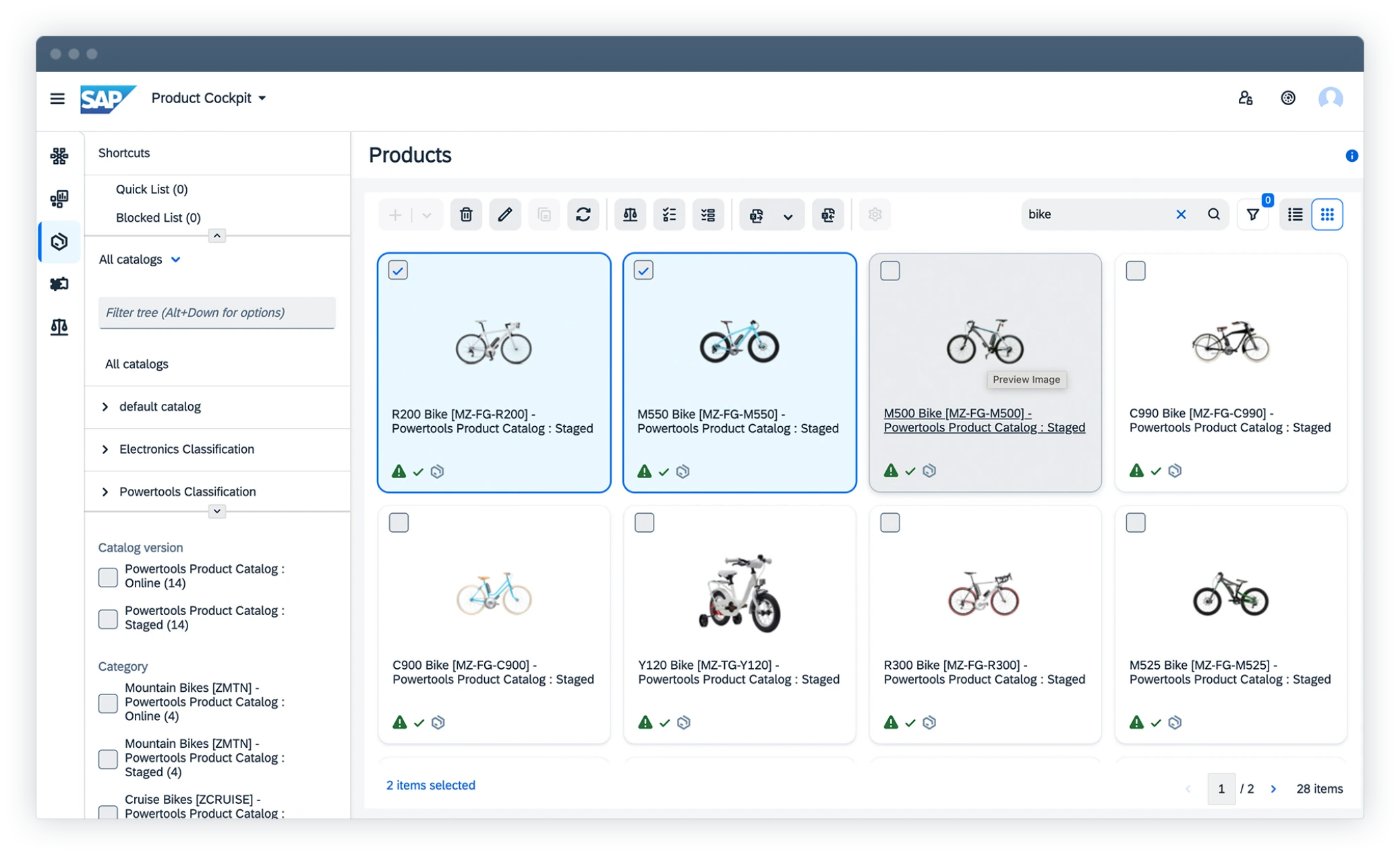
- Order orchestration is another highlight: SAP supports split orders, sourcing logic, and fulfillment routing directly within its commerce engine, reducing dependency on third-party OMS tools.
- For promotions, SAP enables bundle configurations, subscription models, and contract-based pricing, though configuration tends to be more rigid and developer-driven.
However, SAP lacks visual merchandising and low-code promotion tools, which limits agility for non-technical business users. Day-to-day merchandising often requires IT or partner involvement.
Where SAP emphasizes control and backend orchestration, Adobe Commerce puts speed and flexibility first, especially for teams that need to launch promotions quickly or tailor the storefront experience without developer bottlenecks.
- Adobe supports a wide range of product types — including simple, configurable, grouped, bundled, downloadable, and virtual products — with intuitive catalog and bulk-editing tools.
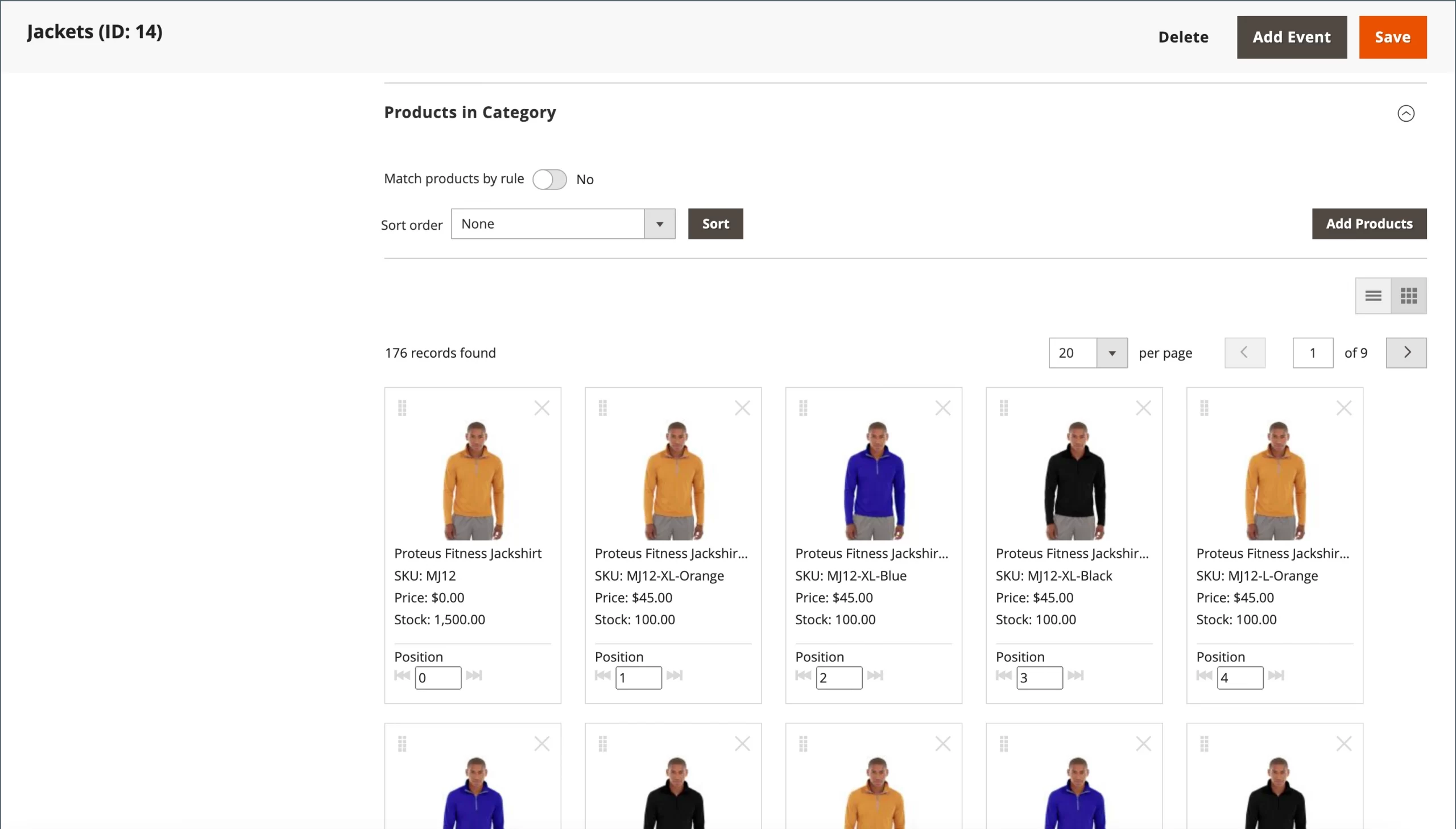
- Its Promotions Engine is highly visual and rule-based, enabling merchants to create dynamic offers (e.g., “Buy X, get Y free” or tiered discounts) with no developer input required. This gives Adobe a major edge in day-to-day promotional agility.
- While Adobe doesn’t offer a native OMS like SAP, it compensates with an open ecosystem and integrations with third-party order management solutions, giving merchants the freedom to assemble their stack.
However, unlike SAP, Adobe doesn't have native enterprise-level product governance or fulfillment logic built-in. Brands with complex supply chains often need to rely on external tools or custom development.
Verdict: Adobe Commerce wins for flexibility and business-user control.
3. B2B and B2C capabilities
SAP Commerce Cloud is built with B2B at its core, making it a top contender for organizations managing complex buyer hierarchies, contract pricing, and multi-org sales structures. Its B2B Accelerator provides native support for:
- Account hierarchies with multiple roles, permissions, and approval workflows — ideal for companies selling to layered procurement teams.
- Customer-specific catalogs and pricing, including negotiated terms, volume-based discounts, and contract enforcement logic tied directly to SAP ERP or CPQ.
- Self-service tools, such as requisition lists, reordering, and budget approvals, which align well with the needs of large enterprise buyers.
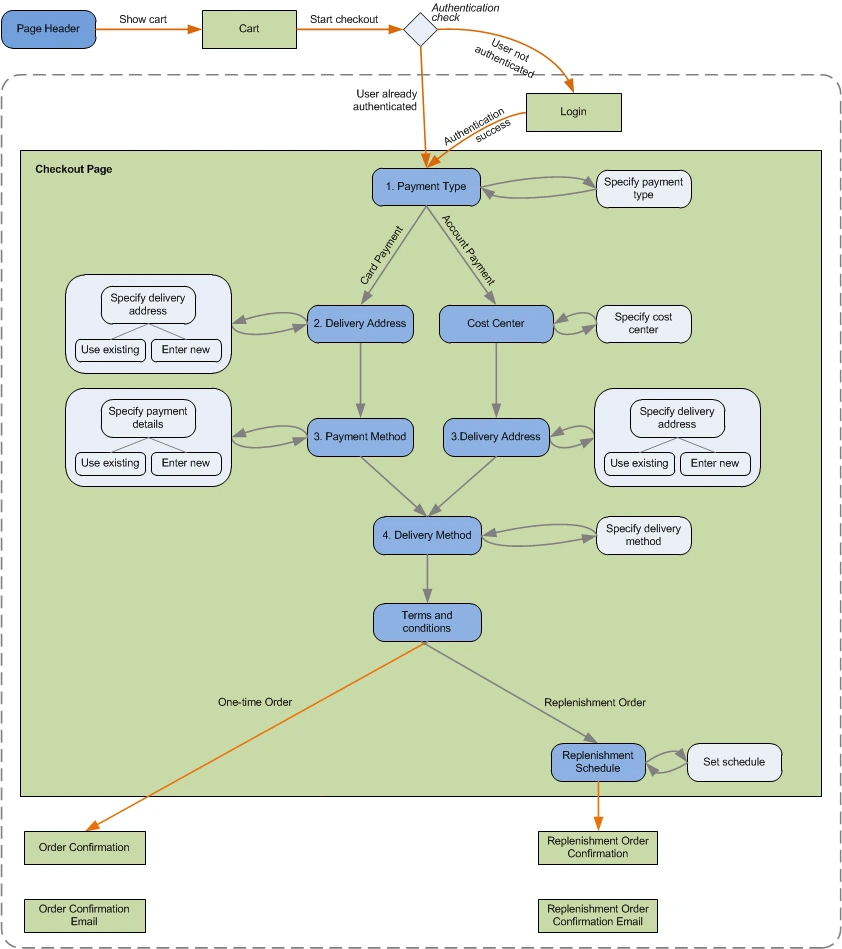
For B2C, SAP enables centralized management of multi-region catalogs, localized content, and regional currencies, along with an Assisted Service Module (ASM) that bridges the gap between digital and human-assisted commerce (e.g., call centers or sales reps completing orders on behalf of customers).
However, B2C execution still tends to be more rigid due to SAP’s backend-first architecture and requires heavier development to adapt to dynamic frontend demands.
Adobe Commerce strongly supports both B2B and B2C models, though it favors businesses that want speed, control, and hybrid selling scenarios.
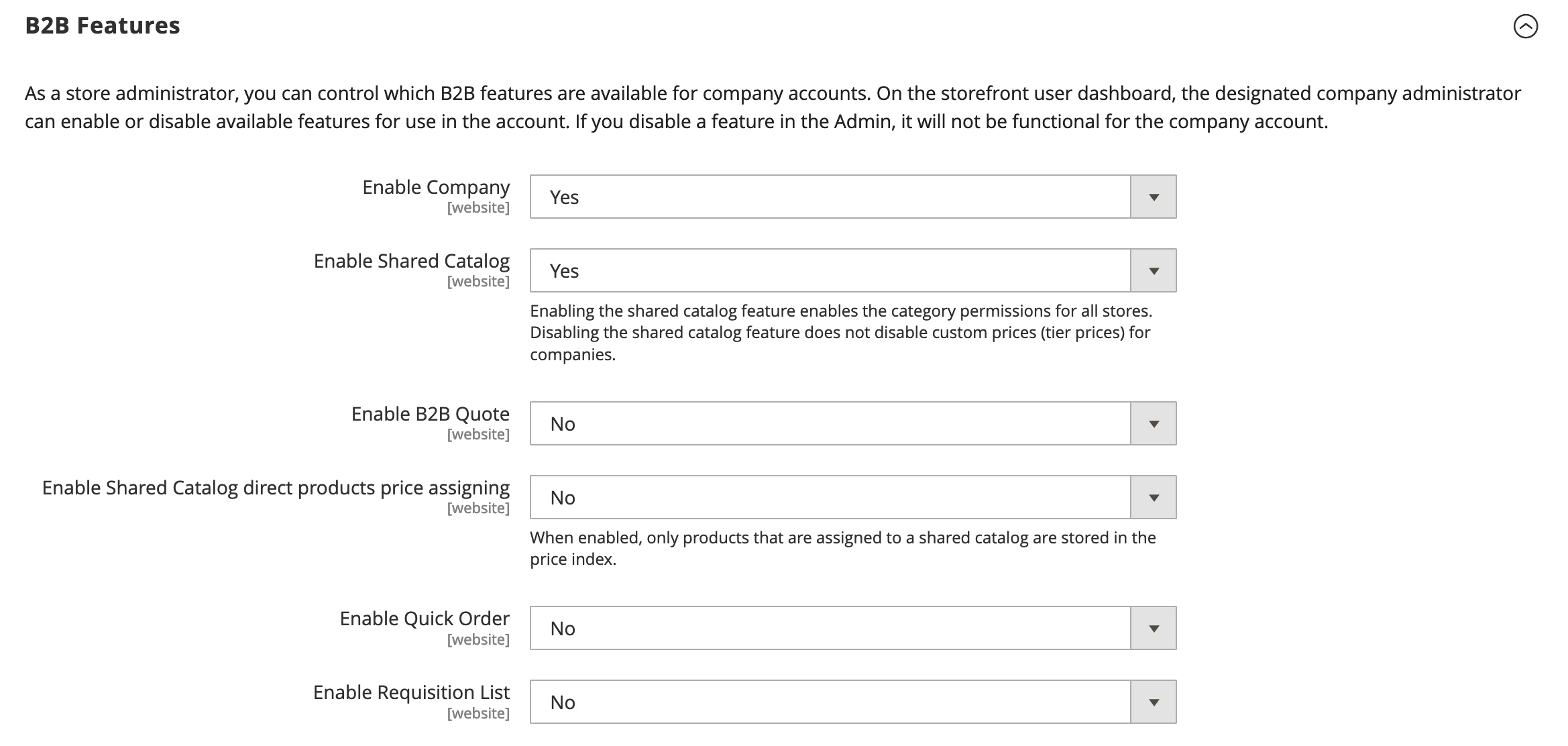
- Its native B2B module supports company accounts, shared catalogs, tiered pricing, purchase order flows, and negotiated quotes, making it a solid choice for mid-market to enterprise sellers.
- Where Adobe shines is in usability: B2B buyers can quickly access quick order forms, manage requisition lists, and place orders on credit, all within a modern, mobile-friendly UI.
- On the B2C front, Adobe leads with customer segmentation, personalized promotions, and robust multilingual, multi-storefront support — all manageable via the admin without code.
Unlike SAP, Adobe combines its B2B and B2C logic in a single backend, allowing businesses to run hybrid commerce models (e.g., D2C + wholesale) from one system — an operational advantage for brands expanding across channels. That said, Adobe’s B2B functionality, while powerful, isn’t as deeply integrated into ERP logic as SAP’s. For example, complex SAP CPQ configurations or procurement logic may require custom API work or middleware.
Verdict: SAP Commerce Cloud wins for robust B2B orchestration.
4. Scalability and performance
SAP Commerce Cloud is engineered for global-scale operations and excels in high-volume, high-concurrency environments.
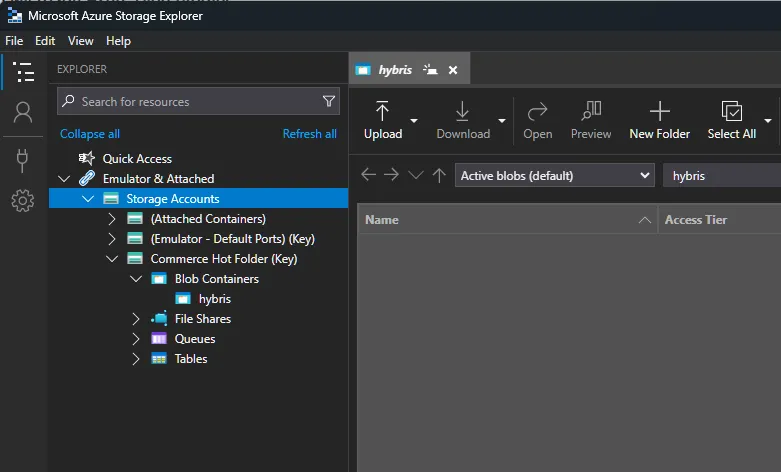
Built on Microsoft Azure, it supports:
- Auto-scaling infrastructure configured through SAP BTP is designed to handle sudden traffic surges without manual intervention.
- Multi-region deployments with localized data center support are critical for enterprise operations across continents.
- Large catalog performance to support millions of SKUs and complex relationships across product hierarchies, price lists, and business units.
However, the platform’s performance tuning and scaling typically depend on SAP-certified partners or internal DevOps teams familiar with SAP BTP and its orchestration layer.
Adobe Commerce offers strong performance for fast-scaling businesses, particularly in mid-to-enterprise D2C and hybrid models. It provides:
- Elastic scaling via Adobe Commerce Cloud’s containerized infrastructure, which adjusts resources automatically during peak periods (e.g., Black Friday).
- A robust CDN setup through Fastly (included in Adobe’s cloud service), plus built-in image optimization and caching layers like Varnish for page speed.
- Performance-focused tooling such as asynchronous reindexing, graphQL query optimization, and content staging to reduce frontend latency.
As you can see, Adobe may require additional optimization (or third-party extensions) when handling extremely large catalogs or advanced B2B fulfillment logic at global scale. Performance tuning can be handled in-house more flexibly than SAP, but doing so well requires experience with Magento internals.
Verdict: SAP Commerce Cloud wins for backend scalability and global reliability.
5. Ease of use and customizability
SAP Commerce Cloud delivers enterprise-grade structure and configurability but at the cost of ease of use. Its backend architecture and tools are tailored more for centralized IT teams and regulated governance models than for fast-moving business users. The Backoffice Cockpit offers deep catalog, order, and pricing management tools, but its UI is complex, with a steeper learning curve even for experienced teams.

SmartEdit, SAP’s visual CMS, allows for basic page editing and layout updates. However, its capabilities are limited compared to Adobe’s Page Builder, particularly in terms of drag-and-drop content flexibility or campaign speed.
On the other hand, Adobe Commerce puts power directly into the hands of merchandisers, marketers, and content managers, offering a platform where front-end teams can work autonomously while developers enjoy deep extensibility.
Its modern admin UI is clean, role-based, and intuitive. Merchants can manage product data, promotions, and orders without needing to involve IT. Page Builder, Adobe’s visual CMS tool, supports drag-and-drop content creation, landing pages, banners, and reusable blocks — all with real-time preview and version control.
Verdict: Adobe Commerce wins for usability and agility.
6. Multichannel and mobile experience
Your commerce platform must enable consistent, responsive experiences across mobile, social, marketplaces, and offline touchpoints. Here’s how Adobe Commerce Magento vs SAP Commerce Cloud compare when it comes to multichannel capabilities and mobile-readiness.
| Capability | SAP Commerce Cloud | Adobe Commerce (Magento) |
| Channel control | Centralized for mobile, telesales, in-store | Native multi-storefront with regional control |
| Frontend tech | Spartacus (Angular), IT-heavy setup | PWA Studio, responsive themes, low-code ready |
| Marketplace integration | Requires third-party middleware | Plug-and-play connectors (Amazon, eBay, etc.) |
| POS support | SAP Retail POS integration | Broad 3rd-party POS ecosystem support |
Verdict: Adobe Commerce wins for multichannel speed and mobile readiness.
7. Marketing and personalization
SAP Commerce Cloud provides effective marketing tools for large businesses through its connections with SAP Emarsys and SAP Customer Data Cloud (CDC). These tools help companies personalize their marketing in a structured, compliant, and scalable way.
With SAP Emarsys, you can automate marketing across various channels, such as email, SMS, and push notifications. You can use set paths for customer journeys, like recovering abandoned shopping carts or re-engaging customers.
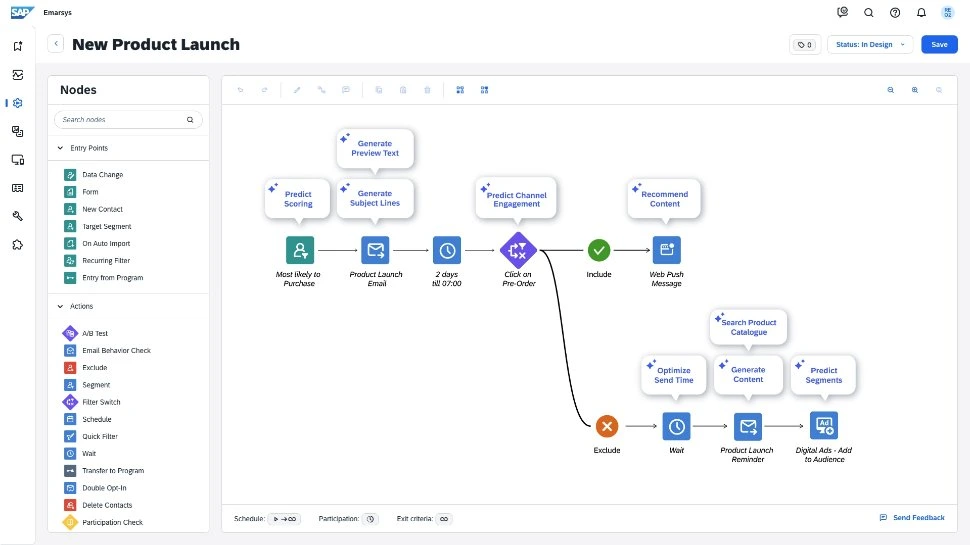
You can create very specific segments and target your audience, usually through SAP Marketing Cloud. This may require help from SAP consultants to set up advanced rules or link with CRM and ERP systems. Emarsys also offers predictive personalization using AI-powered triggers, but these features often come with separate licenses and a more complex setup process.
What about Magento Adobe Commerce?
Adobe generative AI (formerly Adobe Sensei), Adobe’s AI engine, helps with product recommendations, intelligent search, and real-time merchandising directly within the admin interface. It works well with Adobe Target, enabling teams to create A/B tests, multivariate tests, and tailored content experiences without any coding.
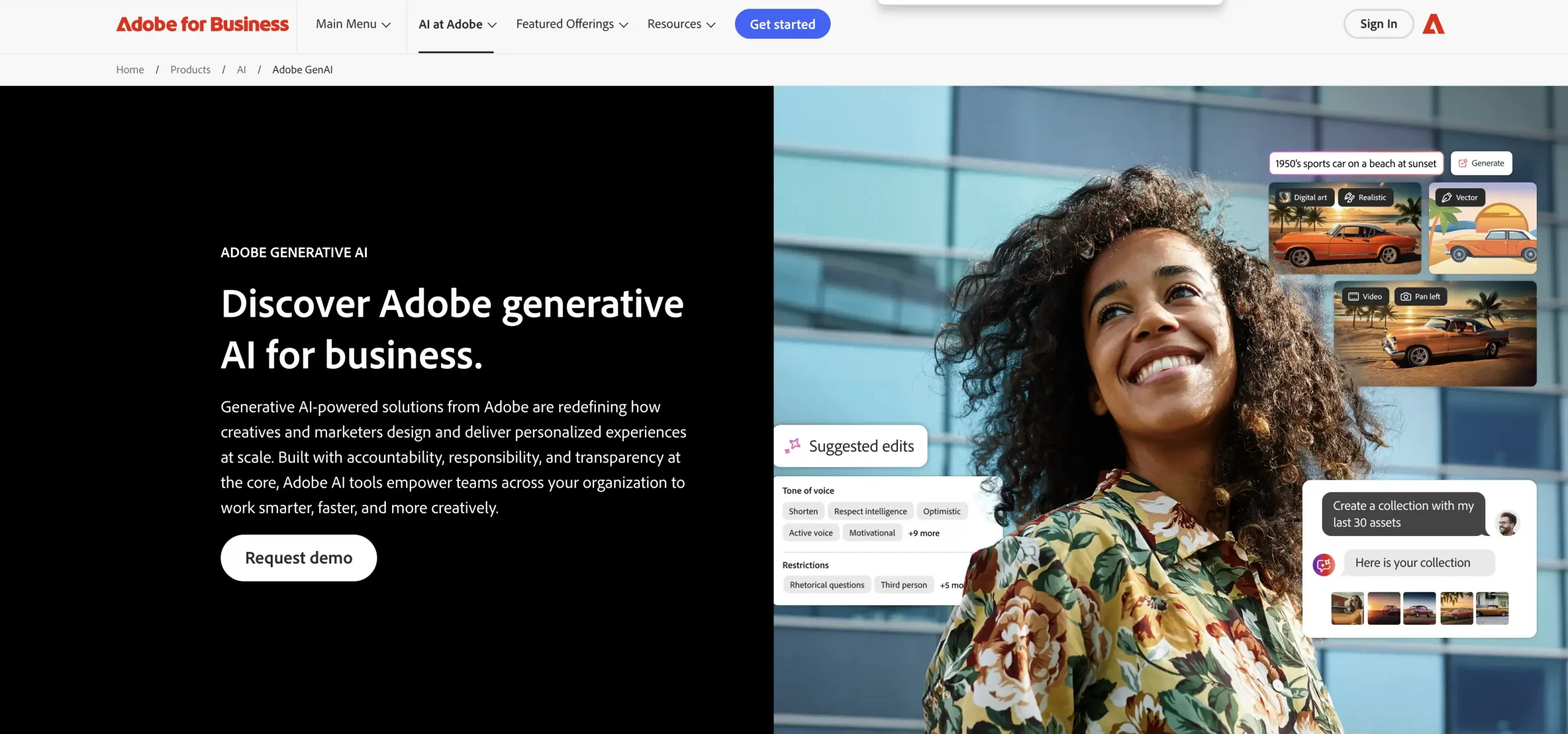
Customer segmentation is dynamic and integrated into promotions, pricing rules, and content visibility. Marketers can create segments based on behavior, cart contents, purchase history, etc. Adobe’s wider Experience Cloud stack, including AEM, Analytics, and Journey Optimizer, helps businesses run highly personalized campaigns across channels, whether for a flash sale or a loyalty program.
Verdict: Adobe Commerce wins for hands-on, AI-powered marketing agility.
8. SEO and content management
SAP Commerce Cloud provides a functional but developer-leaning approach to SEO and content management, suitable for enterprise teams with structured publishing workflows and centralized governance. For SEO, SAP supports clean URLs, editable meta tags, sitemaps, and redirect rules. However, advanced SEO elements like schema markup or Open Graph tags often require manual coding or partner-developed extensions.
The SmartEdit CMS allows content managers to modify banners, product carousels, and layouts. While usable, it’s limited in flexibility and lacks real-time previews, version control, or drag-and-drop capabilities.
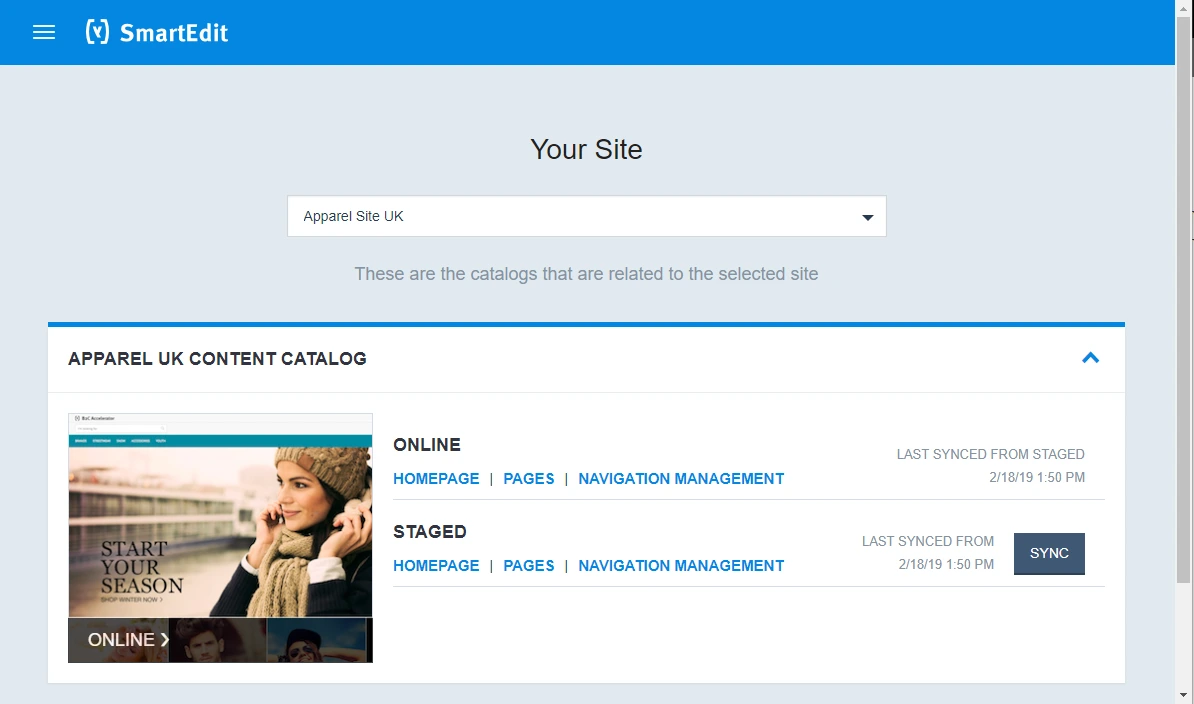
For richer content experiences, enterprises typically integrate SAP Commerce Cloud with external CMS solutions like SAP WorkZone, Adobe Experience Manager, or a headless CMS, adding complexity to the stack. Content staging is available but lacks the seamless preview-and-publish flow modern marketers often expect.
In contrast, Adobe Commerce is built for content-driven commerce, offering marketer-friendly tools and advanced SEO configuration, with minimal reliance on developers.
The SEO toolkit includes full control over meta data, canonical URLs, robots.txt, dynamic sitemap generation, and schema markup — all accessible through the admin. Rich content staging and preview features allow teams to schedule product launches, promotions, and homepage updates with confidence.
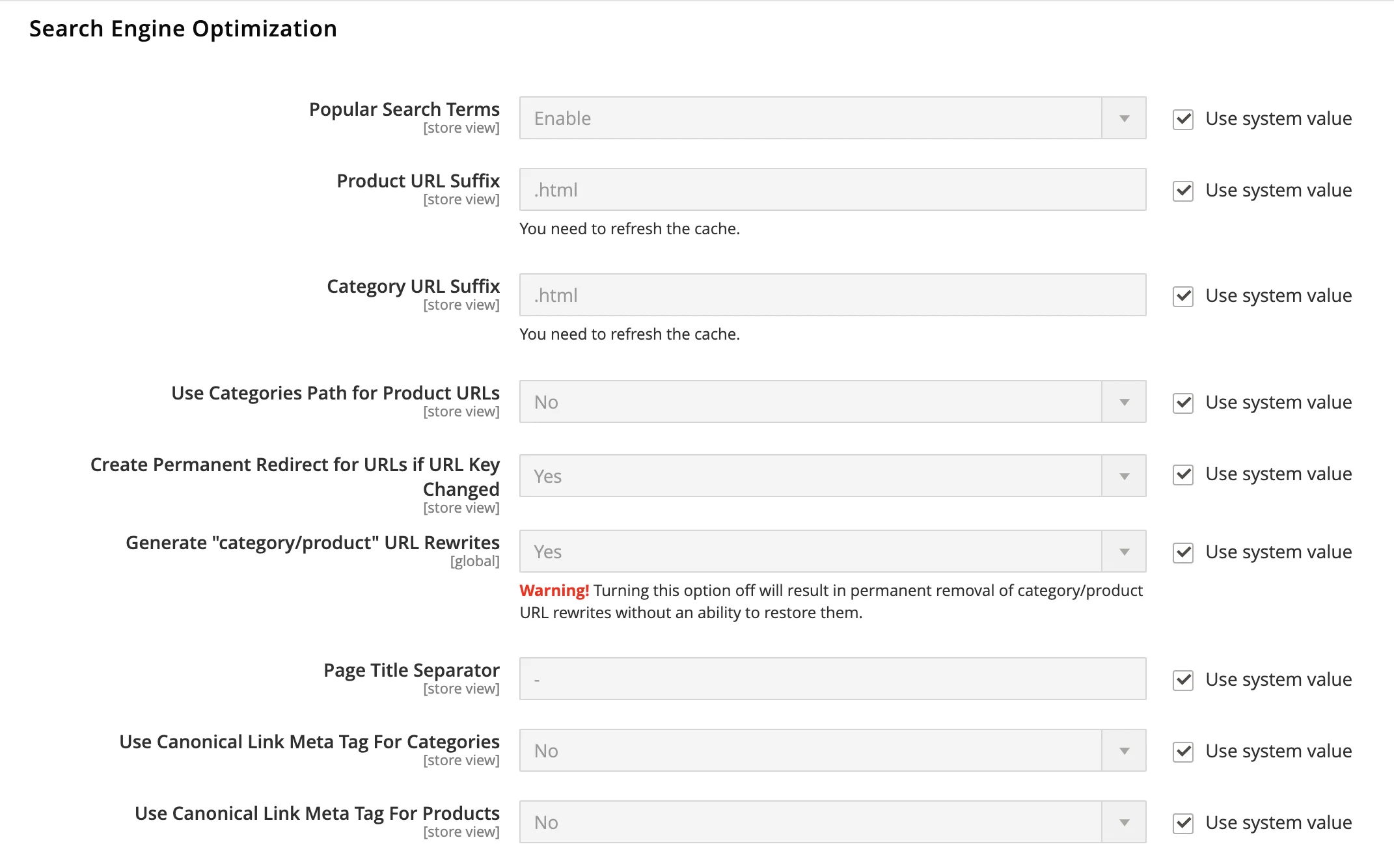
For even more advanced publishing and content orchestration, Adobe Commerce integrates seamlessly with Adobe Experience Manager (AEM), creating a unified experience between content and commerce.
Verdict: Adobe Commerce wins for SEO depth and content agility.
9. Support and documentation
SAP Commerce Cloud offers a structured support system for businesses. You can access 24/7 support through the SAP ONE Support Launchpad. This support includes guaranteed response times and dedicated Technical Account Managers (TAMs) for premium clients.
You can find documentation on the SAP Help Portal, which includes detailed technical resources. However, the portal can be confusing and may require some background knowledge in SAP architecture.

To implement SAP Commerce, you usually need to work with certified partners, especially for big projects or custom work. SAP also provides training options like SAP Learning Hub, openSAP courses, and PartnerEdge, but onboarding can take a lot of time and is often formal.
In contrast, Adobe Commerce takes a more open approach. They provide strong support for enterprise customers and have a large community of developers. Adobe also offers 24/7 enterprise support with guaranteed response times and a comprehensive Help Center and Knowledge Base.
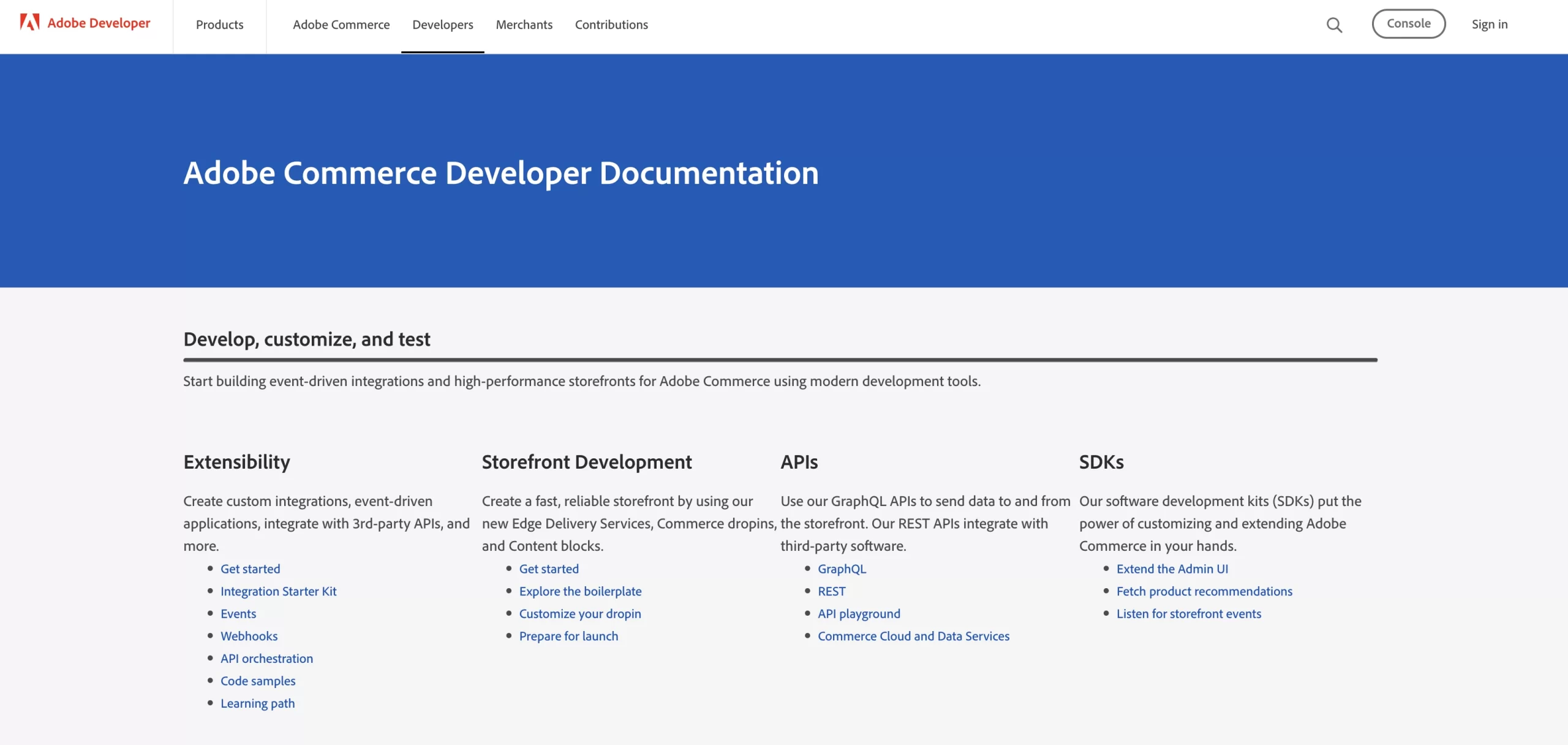
Adobe’s documentation is available publicly at Adobe Commerce Developer Documentation. It is regularly updated and includes many examples, tutorials, and API references. This makes it easier for teams or agencies to build custom features. Thanks to its Magento open-source roots, the Adobe community is active, and developers can quickly find answers on platforms like Stack Overflow, GitHub, and Magento forums.
Verdict: Adobe Commerce wins for accessibility and community-driven support.
10. Security
SAP Commerce Cloud is designed for compliance-heavy enterprises. Hosted on Microsoft Azure, it includes multi-layered protections, standardized audit processes, and native integration with SAP Customer Data Cloud (CDC). It supports global standards such as GDPR, ISO/IEC 27001, 27017, 27018, and SOC 2, making it ideal for organizations in finance, healthcare, manufacturing, and the public sector.
Adobe Commerce offers strong security foundations, especially on Adobe Commerce Cloud. It is PCI DSS Level 1 certified, includes TLS encryption, 2FA for admin access, and the Adobe Security Scanner for real-time threat detection. Patches and updates are coordinated through the Adobe Trust Center, with full admin control and customizable access roles. While Adobe doesn’t offer native identity or consent tools like SAP CDC, it integrates well with third-party compliance tools.
Verdict: It's a tie — SAP Commerce Cloud leads in compliance and identity governance, while Adobe Commerce excels in admin security tools and update velocity.
SAP Commerce Cloud vs Magento: Which Platform Should You Choose?
After comparing SAP Commerce Cloud vs Adobe Commerce (Magento) across pricing, features, scalability, and security, let’s distill the insights into clear recommendations.
Choose Adobe Commerce if you are…
- A mid-sized to large business looking to scale quickly without rigid IT processes
- A D2C or omnichannel brand prioritizing flexibility, fast launches, and design control
- Focused on personalization, marketing agility, and content-driven commerce
- Looking for strong SEO, mobile optimization, and headless capabilities
- Comfortable with a broad partner ecosystem or in-house development teams
Choose SAP Commerce Cloud if you are…
- A large enterprise with complex B2B workflows, extensive catalogs, or multiple business units
- Already invested in SAP S/4HANA, SAP ERP, or other SAP Customer Experience tools
- Needing strict governance, compliance, and enterprise-grade security
- Operating across multiple regions, currencies, and regulatory frameworks
- Prioritizing internal control, SAP-native orchestration, and long-term system stability
Here’s final verdict by business scenario:
Scenario | Recommended platform | Why |
Fast-growing D2C brand focused on UX & agility | Adobe Commerce | Easier to customize, quick to launch, strong marketing/personalization tools |
Enterprise with SAP ERP looking for full-stack integration | SAP Commerce Cloud | Seamless ERP/CRM integration, robust B2B features, long-term centralized control |
Global brand managing multiple regional sites | SAP Commerce Cloud | Multi-org, multi-catalog, contract pricing & localization at scale |
Mid-sized business aiming for omnichannel growth | Adobe Commerce | PWA support, flexible extensions, lower TCO for early growth stages |
Complex B2B business (e.g. industrial supply) | SAP Commerce Cloud | Advanced quoting, fulfillment rules, buyer roles, and SAP-native logic |
Content-first brand needing deep CMS/marketing | Adobe Commerce + AEM | Unified commerce + content + analytics via Adobe Experience Platform |
Thinking of replatforming?
If your current eCommerce platform is holding you back—whether in performance, flexibility, or scalability—it might be time for a move. LitExtension helps businesses migrate across platforms seamlessly, including:
- Magento to SAP
- SAP to Magento
- Other platform-to-platform transitions
We ensure full data integrity, minimal downtime, and zero disruption to ongoing business. Contact us to explore your migration options and design a move that fits your growth strategy.
Magento vs SAP Commerce Cloud: FAQs
What is the difference between Magento and SAP Commerce Cloud?
Magento (now Adobe Commerce) is a flexible, PHP-based eCommerce platform known for its modularity, content + commerce capabilities, and active developer ecosystem. SAP Commerce Cloud, formerly Hybris, is a Java-based enterprise platform tightly integrated with SAP’s ERP and CX suite, built for large-scale, complex B2B/B2C operations.
Which platform is better for B2B commerce?
SAP Commerce Cloud leads in enterprise B2B with features like contract pricing, customer-specific catalogs, SAP CPQ integration, and approval workflows. Adobe Commerce also supports B2B natively (e.g., company accounts, shared catalogs), but is better suited for simpler or hybrid models.
Which one offers better ERP and CRM integration, Magento or SAP Commerce Cloud?
SAP Commerce Cloud integrates natively with SAP S/4HANA, SAP ERP, SAP Customer Data Cloud, and other SAP CX tools—making it the better fit for enterprises on the SAP stack. Adobe Commerce connects with CRMs and ERPs like Salesforce, NetSuite, and Microsoft Dynamics via third-party integrations or middleware.
Which is more suitable for headless and composable commerce setups?
Both platforms support headless commerce:
- Adobe Commerce uses GraphQL APIs and PWA Studio or integrates with AEM.
- SAP Commerce Cloud offers Spartacus (Angular-based frontend) and APIs via SAP BTP.
Adobe Commerce is more flexible and developer-friendly for headless experimentation. SAP Commerce Cloud is stronger in enterprise-grade composable setups with strict architectural governance.
What is SAP Commerce Cloud’s relationship to SAP Hybris?
Hybris was a cloud-based eCommerce platform acquired by SAP in 2013. It was later rebranded as SAP Hybris Commerce, then evolved into SAP Commerce Cloud—now a central part of SAP's Customer Experience (CX) suite, running natively on Microsoft Azure.
How is SAP Hybris different from SAP Commerce Cloud?
SAP Hybris was the original on-premise solution. SAP Commerce Cloud retains Hybris’s core functionality but is now offered as a cloud-native service with integrated DevOps tools, CI/CD pipelines, and infrastructure managed via SAP BTP. The shift to Commerce Cloud reflects a broader focus on SaaS delivery, scalability, and faster updates.
Final Words
Choosing between SAP Commerce Cloud vs Magento (Adobe Commerce) depends on the structure, scale, and priorities of your business.
- If you’re a large enterprise with complex B2B workflows, multiple business units, and deep SAP infrastructure, SAP Commerce Cloud offers unmatched integration, governance, and global scalability.
- If you’re a mid-sized or fast-scaling business looking for agility, frontend flexibility, and marketing empowerment, Adobe Commerce delivers the tools, speed, and ecosystem to execute quickly and grow across channels.
Ultimately, both platforms are capable—what matters is finding the right match for your operating model, team structure, and future roadmap.
We hope you found this article insightful and now have a clear understanding of SAP Commerce Cloud vs Magento (Adobe Commerce). For more content like this, be sure to visit the LitExtension blog and join our eCommerce community to gain further insights and connect with fellow business owners.

